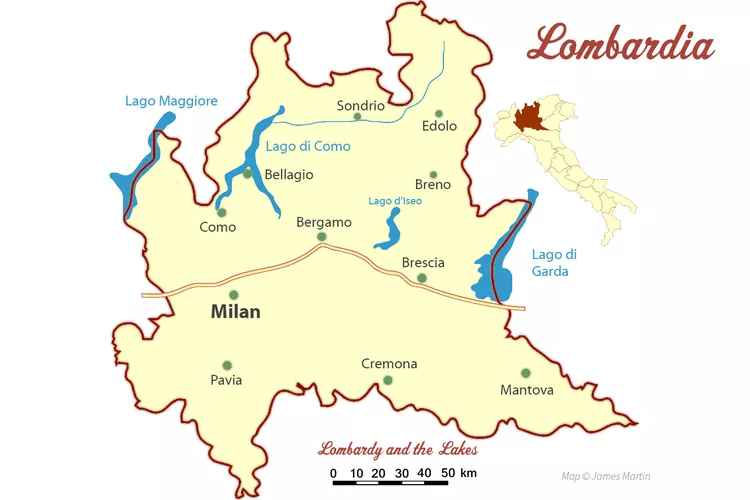Lombardy, or Lombardia in Italian, is a large region in northern Italy where you’ll find the metropolis of Milan, beautiful Renaissance cities like Pavia and Mantua, and the popular lakes district that includes Lakes Como and Iseo, as well as parts of Lakes Maggiore and Garda. Additionally, it boasts beautiful mountains and valleys, one of which contains a fantastic collection of prehistoric rock art sites.
Milan’s Malpensa Airport, being one of Italy’s major international airports, welcomes visitors arriving directly from the United States. The smaller Linate Airport primarily serves flights from other Italian and European cities.
Continue reading to explore Lombardy’s top cities, lakes, and valleys worth visiting.
Milan and Lombardy’s Cities and Towns
From the fashion capital Milan to the picturesque Renaissance city of Mantova, Lombardy offers a wealth of attractions for tourists within a compact area. Here are the top cities to visit in Lombardy:
Milan
Milan, or Milano in Italian, ranks as one of Italy’s top cities and is known for its vibrant fashion scene. This fast-paced city fosters a rich cultural environment, making it a prime destination for shopping enthusiasts and art lovers alike. Noteworthy sites include the largest Gothic cathedral in the world and the renowned Last Supper painting. Some highlights of Milan include:
- Accommodation options in Milan
- Public transportation overview
Brescia
Brescia stands as the second largest city in the Lombardy region but is frequently overlooked by tourists. The city showcases Roman remains, a historical castle, Renaissance squares, and a captivating medieval center. Home to the Santa Giulia City Museum, one of Italy’s best small museums, Brescia also hosts the annual Mille Miglia car race, which both starts and finishes in this historic locale.
Mantova
Mantova, a picturesque and historic city enveloped on three sides by lakes, was once home to one of the greatest Renaissance courts in Europe. Its Renaissance architecture places it within the UNESCO Quadrilateral, a historic district in northeastern Italy recognized for its World Heritage status. The Ducal Palace is reminiscent of a small town with over 500 rooms, featuring exquisite frescoes, while Palazzo Te is celebrated for its unique frescoes, including some that are erotic in nature.
Cremona
Famous for its handmade Stradivarius violins, Cremona boasts a dedicated museum for violins. The city’s charming historic center is compact and easily navigable on foot, while the towering cathedral bell tower is home to the world’s largest astronomical clock.
Pavia
Pavia, a university city situated along the banks of the Ticino River, features Romanesque and medieval architecture alongside a well-preserved historic center. Nearby, the famous Certosa di Pavia monastery can be conveniently reached by bus.
Bergamo
Bergamo is divided into two parts: the ancient city of Bergamo Alta, perched on a hill, and the modern Bergamo Bassa. Bergamo Alta is characterized by its medieval walls, historic squares, majestic monuments, and breathtaking views. Visitors will find a small airport nearby that accommodates several European budget airlines.
Lakes and Valleys of Lombardy

Lake Como is renowned as Italy’s most popular lake, surrounded by stunning villas and quaint resort villages. The area is ideal for water sports, hiking, and nearby winter activities. For additional information, consider exploring a Lake Como map.
Lake Maggiore extends into Switzerland, providing year-round recreational activities. This lake is favored by both tourists and Milanese locals who flock to Lago Maggiore for weekend getaways.
Lago d’Iseo is a less-crowded alternative that features water sports, a nature reserve, and an atmosphere of relaxation. The area also encompasses the unusual earth pyramids, a rare natural phenomenon that captivates visitors.
Lake Garda, or Lago di Garda, represents Italy’s largest lake. Although the western segment lies within Lombardy, the lake spans two additional regions. The northern part of the lake showcases particularly breathtaking scenery. Nearby, Gardaland, a major amusement park, adds to the region’s appeal.
Valleys of Lombardy
Lombardy is home to two remarkable valleys in the northern region that provide exceptional hiking opportunities.
Val Camonica, located north of Lago d’Iseo from Breno to Edolo, is celebrated for its abundant prehistoric rock art sites, deeming it one of the finest collections of petroglyphs worldwide. Furthermore, the rock art of Val Camonica achieved the distinction of being Italy’s first UNESCO World Heritage Site. Val Camonica is adorned with medieval villages and castles along with excellent hiking trails, accessible via a regional train that runs up the valley from Brescia.
Valtellina, the northern section of Lombardy stretching from Edolo to the region’s western border through Sondrio, offers numerous skiing opportunities alongside various summer and winter mountain sports activities.





